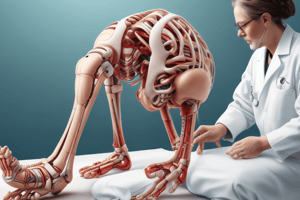Podcast
Questions and Answers
Which of the following is the BEST description of talipes (clubfoot)?
Which of the following is the BEST description of talipes (clubfoot)?
- A progressive deterioration of the joints due to aging and wear.
- A condition exclusively caused by genetic mutations affecting the extracellular matrix.
- A condition that only affects the mobility of the foot but does not impact gait.
- A deformity in which one or both feet are twisted out of their normal position, often involving multiple foot malalignments. (correct)
Which factor is LEAST likely to be associated with the etiology of talipes?
Which factor is LEAST likely to be associated with the etiology of talipes?
- Genetic predisposition.
- Postnatal trauma to the foot. (correct)
- Intrauterine environmental factors like oligohydramnios.
- Maternal smoking during pregnancy.
Which of the following BEST explains how developmental abnormalities contribute to the pathogenesis of talipes?
Which of the following BEST explains how developmental abnormalities contribute to the pathogenesis of talipes?
- They directly cause genetic mutations in the developing foot.
- They disrupt the normal formation of bones, tendons, and ligaments due to improper positioning and movement in the womb. (correct)
- They only affect the cosmetic appearance of the foot with no functional impact.
- They induce maternal smoking, leading to fetal deformities.
Which morphological change is NOT typically associated with talipes?
Which morphological change is NOT typically associated with talipes?
Why is early detection and treatment of talipes clinically significant?
Why is early detection and treatment of talipes clinically significant?
What is the PRIMARY method for diagnosing talipes?
What is the PRIMARY method for diagnosing talipes?
What is the MOST likely long-term outcome for a child with talipes who receives appropriate treatment?
What is the MOST likely long-term outcome for a child with talipes who receives appropriate treatment?
Which of the following is NOT a recognized component of the typical presentation of talipes?
Which of the following is NOT a recognized component of the typical presentation of talipes?
What role do genetic mutations play in the pathogenesis of talipes?
What role do genetic mutations play in the pathogenesis of talipes?
What type of imaging could be used to evaluate soft tissue or neurovascular abnormalities associated with talipes?
What type of imaging could be used to evaluate soft tissue or neurovascular abnormalities associated with talipes?
Flashcards
Talipes (Clubfoot)
Talipes (Clubfoot)
A deformity where one or both feet are twisted out of their normal position, often congenital but can be acquired later.
Etiology of Talipes
Etiology of Talipes
Multifactorial, including genetic predisposition, intrauterine environment (like uterine crowding), and environmental factors (like maternal smoking).
Pathogenesis of Talipes
Pathogenesis of Talipes
Involves a combination of genetic and environmental factors leading to developmental abnormalities and altered muscle forces.
Equinus Deformity
Equinus Deformity
Signup and view all the flashcards
Varus Deformity
Varus Deformity
Signup and view all the flashcards
Adduction of the Forefoot
Adduction of the Forefoot
Signup and view all the flashcards
Cavus Deformity
Cavus Deformity
Signup and view all the flashcards
Diagnosis of Talipes
Diagnosis of Talipes
Signup and view all the flashcards
Talipes Treatment
Talipes Treatment
Signup and view all the flashcards
Talipes Prognosis
Talipes Prognosis
Signup and view all the flashcards
Study Notes
- Talipes, commonly known as clubfoot, is a condition where one or both feet are twisted out of their normal position.
- Talipes is most frequently a congenital condition, meaning it is present at birth, but it can also be acquired later in life due to neuromuscular conditions.
- The deformity involves foot malalignments, including plantarflexion, inversion of the heel, adduction of the forefoot, and an abnormal high arch (cavus).
Etiology of Talipes
- The causes of talipes are multifactorial.
- In many cases, no specific cause is identified, referred to as idiopathic origins.
- A familial tendency can suggest a hereditary component.
- Factors like uterine crowding (oligohydramnios) or abnormal fetal positioning can contribute.
- Neuromuscular disorders such as spina bifida and arthrogryposis are associated conditions.
- Syndromic associations exist where clubfoot is one of several malformations.
- Environmental factors, including maternal smoking or toxin exposure during pregnancy, can contribute.
Pathogenesis of Talipes
- Pathogenesis involves a combination of genetic and environmental influences.
- Improper positioning and movement in the womb may disrupt the normal formation of bones, tendons, and ligaments.
- Abnormal mechanical forces during fetal development can lead to contracted soft tissues.
- Genetic mutations affecting the extracellular matrix or connective tissue development may alter the growth pattern of the foot.
- Imbalance in muscle forces due to neuromuscular dysfunction can further accentuate the deformity.
- These factors result in the distorted alignment of the foot.
Morphological Changes
- Equinus Deformity: The foot is pointed downward (plantarflexed) due to a shortened Achilles tendon.
- Varus Deformity: Indicates the heel is turned inward.
- Adduction of the Forefoot: The front part of the foot is drawn inward.
- Cavus Deformity: An abnormally high arch is present.
- Surrounding ligaments and tendons may be tight or shortened.
- Misalignment or malformation of the tarsal bones accompanies the soft tissue changes.
- Combined abnormalities result in a rigid and deformed foot structure.
Clinical significance
- If untreated, the deformity can severely limit mobility, affect gait, and contribute to early degenerative changes in the joints.
- Persistent disability or pain may impact a person's ability to participate in everyday activities, sports, or work.
- Visible deformities can lead to self-esteem issues and social stigmatization, particularly in children.
- Early detection and treatment are crucial to prevent long-term disability and to optimize function.
Diagnosis of Talipes
- Diagnosis is usually made through clinical examination involving physical assessment of the foot's position, range of motion, and rigidity.
- Clubfoot can often be identified during routine ultrasounds in the later stages of pregnancy.
- X-rays may be used postnatally to assess the alignment of the bony structures, particularly in older infants or complex cases.
- An MRI may be employed to evaluate associated soft tissue or neurovascular abnormalities.
Prognosis of Talipes
- Prognosis largely depends on the timing and method of treatment.
- Non-surgical methods like the Ponseti method, involving gentle manipulation and serial casting, have excellent outcomes when started soon after birth.
- Surgery may be indicated to release contracted tissues or correct bony deformities if non-surgical treatment is insufficient.
- With appropriate treatment, most children achieve near-normal foot function, with long-term follow-up to check for potential relapse or residual deformity.
- Untreated or late-treated talipes can lead to persistent pain, gait abnormalities, and an increased risk of arthritis later in life.
Studying That Suits You
Use AI to generate personalized quizzes and flashcards to suit your learning preferences.
Related Documents
Description
Talipes, or clubfoot, is a condition where the feet are twisted out of position. It is often congenital, but can be acquired later in life. Causes include idiopathic origins, genetics, uterine crowding, neuromuscular disorders and environmental factors.



